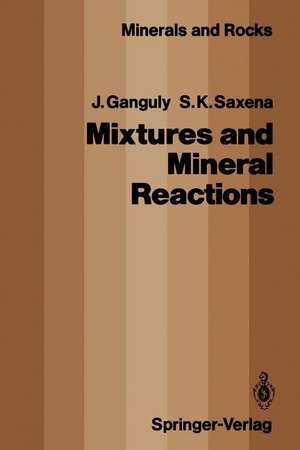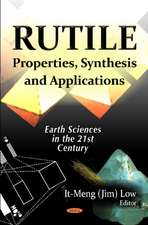Mixtures and Mineral Reactions: Minerals, Rocks and Mountains, cartea 19
Autor Jibamitra Ganguly, Surendra K. Saxenaen Limba Engleză Paperback – 14 mar 2012
Din seria Minerals, Rocks and Mountains
-
 Preț: 378.71 lei
Preț: 378.71 lei - 15%
 Preț: 641.38 lei
Preț: 641.38 lei - 15%
 Preț: 692.56 lei
Preț: 692.56 lei - 15%
 Preț: 637.46 lei
Preț: 637.46 lei -
 Preț: 386.00 lei
Preț: 386.00 lei - 15%
 Preț: 639.25 lei
Preț: 639.25 lei - 18%
 Preț: 786.66 lei
Preț: 786.66 lei - 15%
 Preț: 648.42 lei
Preț: 648.42 lei - 15%
 Preț: 645.79 lei
Preț: 645.79 lei -
 Preț: 384.70 lei
Preț: 384.70 lei - 15%
 Preț: 635.65 lei
Preț: 635.65 lei - 18%
 Preț: 897.14 lei
Preț: 897.14 lei - 18%
 Preț: 892.74 lei
Preț: 892.74 lei -
 Preț: 379.86 lei
Preț: 379.86 lei - 15%
 Preț: 697.97 lei
Preț: 697.97 lei -
 Preț: 382.75 lei
Preț: 382.75 lei - 15%
 Preț: 637.78 lei
Preț: 637.78 lei -
 Preț: 386.61 lei
Preț: 386.61 lei -
 Preț: 383.12 lei
Preț: 383.12 lei
Preț: 640.71 lei
Preț vechi: 753.77 lei
-15% Nou
Puncte Express: 961
Preț estimativ în valută:
122.59€ • 128.69$ • 101.76£
122.59€ • 128.69$ • 101.76£
Carte tipărită la comandă
Livrare economică 10-24 aprilie
Preluare comenzi: 021 569.72.76
Specificații
ISBN-13: 9783642466038
ISBN-10: 3642466036
Pagini: 304
Ilustrații: XII, 291 p.
Dimensiuni: 155 x 235 x 16 mm
Greutate: 0.43 kg
Ediția:Softcover reprint of the original 1st ed. 1987
Editura: Springer Berlin, Heidelberg
Colecția Springer
Seria Minerals, Rocks and Mountains
Locul publicării:Berlin, Heidelberg, Germany
ISBN-10: 3642466036
Pagini: 304
Ilustrații: XII, 291 p.
Dimensiuni: 155 x 235 x 16 mm
Greutate: 0.43 kg
Ediția:Softcover reprint of the original 1st ed. 1987
Editura: Springer Berlin, Heidelberg
Colecția Springer
Seria Minerals, Rocks and Mountains
Locul publicării:Berlin, Heidelberg, Germany
Public țintă
ResearchCuprins
1 Thermodynamic Functions of Solutions.- 1.I Fugacity, Activity, and Standard States.- 1.II Partial Molar Quantities, Ideal Solutions, and Excess Functions.- 1.III Dilute Solutions, and More on Standard States.- 2 Mixing Models and Activity-Composition Relations.- 2.I Mixing Models: Macroscopic Formulations.- 2.II Statistical Thermodynamic Formulation of Entropy.- 2.III Ionic and Reciprocal Solutions.- 2.IV Regular and Athermal Solutions.- 2.V Mixing Parameters: Microscopic Considerations.- 2.VI Quasi-Chemical Model.- 2. VII Comparison of Mixing Models.- 2. VIII Cation Ordering and a-X Relations.- 3 Phase Separation in Solutions.- 3.I Free Energy-Composition Relation and Stability of a Solution.- 3.II P-T Dependence of Unmixing.- 3.III Decomposition Mechanisms and Thermal History.- 3.IV Coherent Exsolution.- 3.V Lamellar Spacing and Thermal History.- 3.VI Critical, Binodal, and Spinodal Conditions.- 3.VII Displacement of a Binary Solvus Due to a Dilute Third Component.- 4 Heterogeneous Chemical Reaction and Equilibrium.- 4.I Equilibrium Constant and Activity.- 4.II Phase Rule and Duhem’s Theorem.- 4.III Polymorphism and Phase Transformations.- 4.IV P-T Slopes of Equilibrium Boundaries.- 4. V Effects of Additional Components on Mineral Equilibria.- 4. VI Computation of Equilibrium Assemblages in a Closed System.- 5 Thermodynamic Properties of Selected Mineral Solid Solutions.- 5.I Silicate Garnets.- 5.II Olivine.- 5.III Pyroxenes.- 5.IV Micas.- 5.V Feldspars.- 5.VI Nepheline-Kalsilite.- 5.VII Spinels.- 5.VIII Rhombohedral Carbonates.- 6 Exchange Equilibrium and Inter-Crystalline Fractionation.- 6.I Thermodynamics of Element Fractionation.- 6.II Retrieval of Mixing Parameters from Element Fractionation Data.- 6.III Element Fractionation Between Natural Minerals:Comparison with Thermodynamic Theory.- 6.IV Thermodynamics of Isotope Fractionation.- 6. V Exchange Equilibria and Geothermometry.- 7 Atomic Ordering in Minerals.- 7.I Introduction and General Concepts.- 7.II Relationship Between Disordering Energy and Long-Range Order.- 7.III Systematics of Fe2+-Mg Ordering in Ferromagnesian Silicates.- 7.IV Ordering and Macroscopic Mixing Properties.- 7.V Free Energy vs. Ordering Relation.- 7.VI Ordering, Site Geometries, and Intercrystalline Fractionation.- 7.VII Order-Disorder Transformations in Solid Solutions.- 7.VIII Cation Ordering and Thermal History.- 8 Estimation and Extrapolation of the Thermodynamic Properties of Minerals and Solid Solutions.- 8.I Excess Mixing Properties of Solid Solutions.- 8.II Thermochemical Data on Pure Phases.- 8.III Direct Estimation of Free Energy of Formation.- Appendix A Explanatory Notes.- A.I Crystal Field Theory.- A.II Electronegativity.- A. III Interdiffusion Coefficient.- A.IV Temperature-Time-Transformation (TTT) Diagram.- Appendix B Geothermometric and Geobarometric Formulations of Selected Mineral Reactions.- B.I Continuous Reactions.- B.II Discontinuous Reactions.- Appendix C Fluids at High Pressure and Temperature.- C.I Equations of State.- C.II The Virial Equations.- C.III Nonvirial Equations.- C.IV Computation of Pure Fluid Fugacities.- References.







